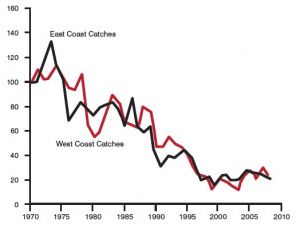Does anyone care?: This week, the Atlantic Salmon Trust published a news article titled ‘Let’s Talk About Aquaculture’. This begins by stating that the AST’s mission is to halt and reverse the decline in wild salmon and sea trout by influencing policy change through science and action. The newsletter then quotes the AST’s policy statement on aquaculture:
‘‘It is beyond doubt that salmon and sea trout can suffer from the presence of open pen salmon aquaculture, due primarily to a combination of harm from sea lice infestations and interbreeding with farm escapees. These problems have severely impacted individual populations of wild salmon and sea trout. It is for this reason the Atlantic Salmon Trust remains strongly opposed to unsustainable open pen aquaculture.’’
Meanwhile, Wild Fish Conservation are campaigning to persuade restaurants to take farmed salmon off their menus.
And let’s not forget that Fisheries Management Scotland employ an Aquaculture Interactions Manager, paid for by Marine Scotland, yet do not employ any managers to specifically look at any of the other issues affecting wild salmon.
Finally, the Scottish Government has instructed SEP to impose a sea lice risk assessed framework on the salmon farming industry.
One certainly would get the impression from these actions that salmon farming is the most overriding issue for wild fish in Scotland. If only salmon farming could be more stringently controlled, or even better removed, then Scottish rivers will again be teeming with stocks of wild salmon and sea trout.
I am trying to restrict the length of this week’s reLAKSation, because instead of spending your time reading 2000 plus words, I would really like you to spend 37 minutes listening to the BBC Scotland radio programme found at the link below. This was uncovered by a long-time friend, to whom I am extremely grateful for passing it on to me.
I can only describe this broadcast from 1986 as eye-opening or jaw dropping. It has also been described to me as both amazing and chilling.
If the link doesn’t open, then copy and paste it into your browser.
The programme was broadcast twice on Radio Scotland in August 1986 and Jan 1987. The reporter was John Kerr, and the producer was Ian Cowie.
Whilst the fate of west coast salmon and sea trout during the late 1980s are still a regular topic for conversation amongst the wild fish community, little is ever said about the issues covered in this broadcast. Salmon farming is blamed for collapses of catches on the west coast but why could the collapse on the west coast not be connected to the declines in the east that were happening at the same time? It is all too easy to blame salmon farming but at the time of broadcast, the most contentious salmon farm in Scotland in Loch Ewe would not even be constructed for at least another year. Farmed salmon production in 1986 was just over 10,000 tonnes. This production came from 117 sites, 85 of which produced less than 100 tonnes each with the remaining producing no more than 300 tonnes. Compared to today’s output, this was insignificant. Production has expanded over twenty times that amount and yet, there are still stocks of wild salmon in the locality that are sufficiently robust that anglers are allowed to kill the fish they catch. In addition, whilst the wild fish sector like to highlight that catches by angling were very different on the east and west coasts, total exploitation is remarkably similar. Rather than being different, the fate of salmon on both coasts looks extremely similar. This is a graph which is never shared in any discussions about the fate of wild salmon.


